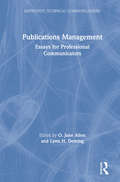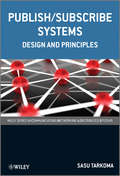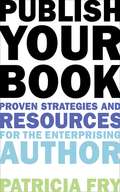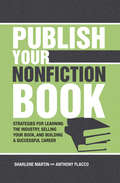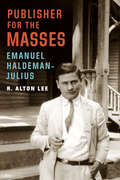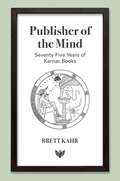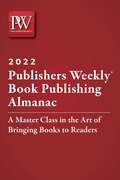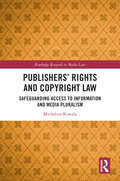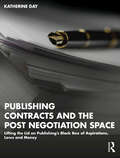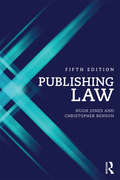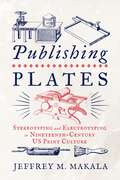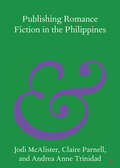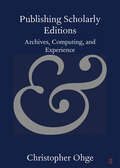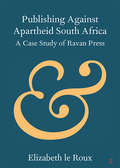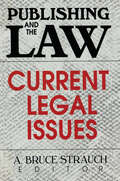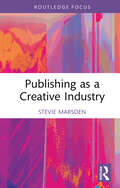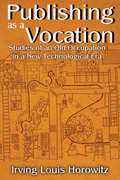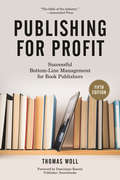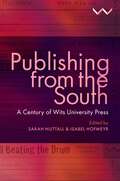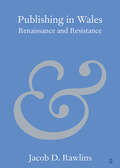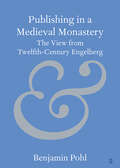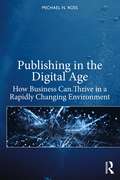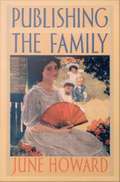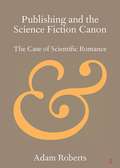- Table View
- List View
Publications Management: Essays for Professional Communicators (Baywood's Technical Communications)
by O. Jane Allen Lynn H Deming"Publications Management: Essays for Professional Communicators" is a collection of essays designed for use in academic programs in technical and professional communication and for communication professionals in the workplace. The contributors include publications managers in the workplace and academics who teach in technical and professional communication programs. Their multiple perspectives offer a broad introduction to some of the important issues publications.
Publish / Subscribe Systems
by Sasu TarkomaThis book offers an unified treatment of the problems solved by publish/subscribe, how to design and implement the solutionsIn this book, the author provides an insight into the publish/subscribe technology including the design, implementation, and evaluation of new systems based on the technology. The book also addresses the basic design patterns and solutions, and discusses their application in practical application scenarios. Furthermore, the author examines current standards and industry best practices as well as recent research proposals in the area. Finally, necessary content matching, filtering, and aggregation algorithms and data structures are extensively covered as well as the mechanisms needed for realizing distributed publish/subscribe across the Internet.Key Features:Addresses the basic design patterns and solutionsCovers applications and example cases including; combining Publish/Subscribe with cloud, Twitter, Facebook, mobile push (app store), Service Oriented Architecture (SOA), Internet of Things and multiplayer gamesExamines current standards and industry best practices as well as recent research proposals in the areaCovers content matching, filtering, and aggregation algorithms and data structures as well as the mechanisms needed for realizing distributed publish/subscribe across the InternetPublish/Subscribe Systems will be an invaluable guide for graduate/postgraduate students and specialists in the IT industry, distributed systems and enterprise computing, software engineers and programmers working in social computing and mobile computing, researchers. Undergraduate students will also find this book of interest.
Publish Your Book: Proven Strategies and Resources for the Enterprising Author
by Patricia FryPublish Your Book: Proven Strategies and Resources for the Enterprising Author is a professional guide to publishing success for the new and struggling author. With insider tips, up-to-date marketing strategies, timelines, and other resources, this book offers a comprehensive tour of the world of book publishing to help authors successfully navigate the industry.Whether you write fiction or nonfiction, this book will help you write your book for a target audience, build promotion into your book, write a successful query letter and book proposal, choose the right publishing option for your book, establish or strengthen your platform, get your book into bookstores, and successfully promote and sell your book. Authors and publishers in any genre and at any stage of the publishing process will benefit from this comprehensive resource, which is an exceptional companion to Promote Your Book (Allworth Press, 2011).
Publish Your Nonfiction Book
by Anthony Flacco Sharlene MartinPublishing Your Nonfiction BookIn Publish Your Nonfiction Book, successful literary agent Sharlene Martin and noted novelist and nonfiction author Anthony Flacco draw on their years of experience to provide you with an in-depth understanding of what the publishing industry is really like and how to successfully navigate it in order to ensure a long-term career.You'll learn:Techniques for writing a strong query letter that hooks agents and editors right from the startStrategies for putting together a stellar proposal package that successfully pitches you and your bookMethods for creating a respectable author platform - before you start pitching your bookTips for getting an agent and building a lasting working relationshipAnd much, much more!Plus, the authors examine actual query letters and proposals that worked, so you can see firsthand exactly what catches an agent's attention and why.Publish Your Nonfiction Book is the one-on-one agent consultation you need - but seldom get - to learn the ropes and seal the deal.
Publish Yourself: Create & Sell Your Own E-Books
by J. M. SnyderIf you've ever wanted to retain more of your royalties or try publishing e-books but didn't know where to start, this book is for you!Recently e-books have exploded onto the publishing scene, making it easier than ever for writers to break into the market. But many people who read e-books aren't familiar with how to create them. What formats should you offer? Where do you sell them? What do you use for a cover? And, most important, how do you go from a Word document to an EPUB, MOBI, or PDF file?Best-selling, multi-published author J.M. Snyder has written this no-nonsense, hands-on guide. She takes the mystery out of e-publishing while making the process of creating an e-book simple, cheap, and easy.Using Microsoft Word (or an equivalent word processing program) along with inexpensive or free software readily available online, you will learn how to create the nine most common e-book formats. You will be walked through cover art design, interior book layout, and e-book creation, as well as given many of the tips J.M. has learned along the way. Also included is a brief guide to online bookstores where you can sell your finished e-book.Let J.M. Snyder help you discover how easy it is to publish yourself!
Publisher for the Masses, Emanuel Haldeman-Julius
by R. Alton LeeHis admirers called him the “Barnum of Books” and the “Voltaire of Kansas” because of his ability to bring culture and education to the people. R. Alton Lee brings to life Emanuel Haldeman-Julius (1889–1951), a writer-publisher-entrepreneur who was one of America’s most significant publishers and editorialists of the twentieth century. His company published a record 500,000,000 copies of 2,580 titles and was second only to the U.S. Government Printing Office in the quantity of publications it produced. Lee details Haldeman-Julius’s family origins in Russia and his formative years in Philadelphia, where he learned the book trade. As a writer and editor for the Social Democrat, Sunday Call, and Western Comrade, Haldeman-Julius was already well known by the time he launched his own publishing company. Haldeman-Julius knew, was nurtured by, and published writers such as Jack London, Upton Sinclair, Jane Addams, Emma Goldman, H. L. Mencken, Carl Sandburg, Eugene V. Debs, Clarence Darrow, Job Harriman, Will Durant, and Bertrand Russell, among others. Based in Girard, Kansas, his company, Haldeman-Julius Publications, covered socialist politics, the philosophy of free thought, and both new and classic books marketed to ordinary Americans, including the Little Blue Book series of classics in Western thought and literature. This biography of the enigmatic and energetic Haldeman-Julius opens a window into the fascinating world of early twentieth-century radical politics and publishing.
Publisher of the Mind: Seventy-Five Years of Karnac Books
by Brett KahrKarnac Books was founded on 24 March 1950 by Harry Karnac as a general interest bookshop at Gloucester Road, London SW7. Following strong sales of a D. W. Winnicott title, Harry Karnac began to increase his stock of mental health titles until they came to occupy the full floor of the shop's basement. Word spread through the global mental health community and Karnac Books became the epicentre for English mental health publications, not only as a must-visit venue but also as a thriving mail-order business. Before long, Harry took the plunge into publishing alongside bookselling and the Karnac imprint was born. Since 1950, Karnac has changed hands several times and Brett Kahr has met, befriended, and interviewed every single owner from the eponymous Harry Karnac to the present day. His detailed knowledge as customer, author, and friend of Karnac makes him the perfect person to write this history, undertaken as a labour of love and published to celebrate Karnac's 75th anniversary. The book begins with an amusing introduction on the welcome affliction of Karnacitis, swiftly followed by a comprehensive history of early psychoanalytic publishing before leading into the first instalment of the chronicles of Karnac. The behind-the-scenes story of the iconic Karnac Books shows why it rose to be a pivotal member of the mental health community and continues to this day.
Publishers Weekly Book Publishing Almanac 2022: A Master Class in the Art of Bringing Books to Readers
by Publishers WeeklyAnnouncing the first edition of Publishers Weekly Book Publishing Almanac 2022. Designed to help authors, editors, agents, publicists, and anyone else working in book publishing understand the changing landscape of book publishing, it is an essential reference for anyone who works in the industry. Written by industry veterans and co-published with Publishers Weekly magazine, here is the first-ever book to offer a comprehensive view of how modern book publishing works. It offers history and context, as well as up-to-the-minute information for anyone interested in working in the field and for authors looking to succeed with a publisher or by self-publishing. You&’ll find here information on: Finding an agentSelf-publishingAmazonBarnes & Noble and other book chainsIndependent bookstores Special sales (non-traditional book markets)DistributionForeign marketsPublicity, Marketing, AdvertisingSubsidiary rightsBook productionE-books and audiobooksDiversity, equity, and inclusion across the industryAnd more! Whether you&’re a seasoned publishing professional, just starting out in the business, or simply interested in how book publishing works, the Publishers Weekly Book Publishing Almanac will be an annual go-to reference guide and an essential, authoritative resource that will make that knowledge accessible to a broad audience. Featuring original essays from and interviews with some of the industry's most insightful and innovative voices along with highlights of PW's news coverage over the last year, the Publishers Weekly Book Publishing Almanac is an indispensable guide for publishers, editors, agents, publicists, authors and anyone who wants better to understand this business, its history, and its mysteries.
Publishers’ Rights and Copyright Law: Safeguarding Access to Information and Media Pluralism (Routledge Research in Media Law)
by Michalina KowalaThis book assesses the related rights of press publishers in the context of access to information and media pluralism.Discussing Art. 15 of the Directive (EU) 2019/790 of 17 April 2019, the book looks to create balance between publishers’ rights and both the protection of freedom of expression and freedom of information. With the rise of AI and an increasing interest on internet users’ right to access information, the book focuses on online platforms and the dissemination of information as well as on the legal challenges posed by the use of AI to produce and disseminate news. Using the French transposition of Art. 15 as a case study and referring to its implementation in numerous Member States, the book discusses the broad picture of publishers’ protection across Europe and even further, as international case studies in Australia and Canada are also discussed.The book will be of interest to researchers in the field of media law, EU law, copyright law and freedom of information.
Publishing Contracts and the Post Negotiation Space: Lifting the Lid on Publishing’s Black Box of Aspirations, Laws and Money
by Katherine DayMany writers dream of having their work published by a respected publishing house, but don’t always understand publishing contract terms – what they mean for the contracting parties and how they inform book-publishing practice. In turn, publishers struggle to satisfy authors’ creative expectations against the industry’s commercial demands. This book challenges our perceptions of these author–publisher power imbalances by recasting the publishing contract as a cultural artefact capable of adapting to the industry’s changing landscape. Based on a three-year study of publishing negotiations, Katherine Day reveals how relational contract theory provides possibilities for future negotiations in what she describes as a ‘post negotiation space’. Drawing on the disciplines of cultural studies, law, publishing studies and cultural sociology, this book reveals a unique perspective from publishing professionals and authors within the post negotiation space, presenting the editor as a fundamental agent in the formation and application of publishing’s contractual terms.
Publishing Law
by Christopher Benson Hugh JonesPublishing Law is an authoritative and engaging guide to a wide range of legal issues affecting publishing today. Hugh Jones and Christopher Benson present readers with clear and accessible guidance to the complex legal areas specific to the ever evolving world of contemporary publishing, including copyright, moral rights, contracts and licensing, privacy, confidentiality, defamation, infringement and trademarks, with analysis of legal issues relating to sales, advertising, marketing, distribution and competition. This new fifth edition presents updated coverage of the key principles of copyright , as well as new copyright exceptions, licensing and open access. There is also further in-depth coverage of the legal issues around the sale of digital content. Key features of the fifth edition include: updated coverage of EU and UK copyright, including a new chapter on copyright exceptions following the significant changes in the 2014 Regulations Comprehensive coverage of publishing contracts with authors, as well as with other providers, including translators, contributors and contracts for subsidiary rights up to date coverage of the Defamation Act 2013, and other changes to EU and UK legislation exploration of the legal issues relating to digital publishing, including eBook and other electronic agreements, data protection and online issues in relation to privacy, and copyright infringement a range of summary checklists on key issues, ranging from copyright ownership to promotion and data protection useful appendices offering an A to Z glossary of legal terms and lists of useful address and further reading.
Publishing Plates: Stereotyping and Electrotyping in Nineteenth-Century US Print Culture (Penn State Series in the History of the Book)
by Jeffrey M. MakalaFirst realized commercially in the late eighteenth century, stereotyping—the creation of solid printing plates cast from moveable type—fundamentally changed the way in which books were printed. Publishing Plates chronicles the technological and cultural shifts that resulted from the introduction of this technology in the United States.The commissioning of plates altered shop practices, distribution methods, and even the author-publisher relationship. Drawing on archival records, Jeffrey M. Makala traces the first uses of stereotyping in Philadelphia in 1812, its adoption by printers in New York and Philadelphia, and its effects on the trade. He looks closely at the printers, typefounders, authors, and publishers who watched small, regional, artisan-based printing traditions rapidly evolve, clearing the way for the industrialized publishing industry that would emerge in the United States at midcentury. Through case studies of the publisher Mathew Carey and the American Bible Society, one of the first publishers of cheap Bibles, Makala explores the origins of the American publishing industry and American mass media. In addition, Makala examines changes in the notion of authorship, copyright, and language and their effects on writers and literary circles, giving examples from the works and lives of Herman Melville, Sojourner Truth, Edgar Allan Poe, Henry David Thoreau, and Walt Whitman, among others. Incorporating perspectives from the fields of book history, the history of technology, material culture studies, and American studies, this book presents a rich, detailed history of an innovation that transformed American culture.
Publishing Romance Fiction in the Philippines (Elements in Publishing and Book Culture)
by Jodi McAlister Claire Parnell Andrea Anne TrinidadThe romance publishing landscape in the Philippines is vast and complex, characterised by entangled industrial players, diverse kinds of texts, and siloed audiences. This Element maps the large, multilayered, and highly productive sector of the Filipino publishing industry. It explores the distinct genre histories of romance fiction in this territory and the social, political and technological contexts that have shaped its development. It also examines the close connections between romance publishing and other media sectors alongside unique reception practices. It takes as a central case study the Filipino romance self-publishing collective #RomanceClass, analysing how they navigate this complex local landscape as well as the broader international marketplace. The majority of scholarship on romance fiction exclusively focuses on the Anglo-American industry. By focusing here on the Philippines, the authors hope to disrupt this phenomenon, and to contribute to a more decentred, rhizomatic approach to understanding this genre world.
Publishing Scholarly Editions: Archives, Computing, and Experience (Elements in Publishing and Book Culture)
by Christopher OhgePublishing Scholarly Editions offers new intellectual tools for publishing digital editions that bring readers closer to the experimental practices of literature, editing, and reading. Sections 1 and 2 frame intentionality and data analysis as intersubjective, interrelated, and illustrative of experience-as-experimentation. In them, I explore these ideas in two editorial projects of nineteenth-century works: Herman Melville's Billy Budd, Sailor and the anti-slavery anthology The Bow in the Cloud, edited by Mary Anne Rawson. Section 3 uses philosophical Pragmatism to rethink editorial principles and data modelling, arguing for a broader conception of the edition rooted in data collections and experience. The Conclusion draws attention to the challenges of publishing digital editions, and why they have failed to be supported by the publishing industry. If publications are conceived as pragmatic 'inventions' based on reliable, open-access data collections, then editing will embrace the critical, aesthetic, and experimental affordances of editions of experience.
Publishing against Apartheid South Africa: A Case Study of Ravan Press (Elements in Publishing and Book Culture)
by Elizabeth le RouxIn many parts of the world, oppositional publishing has emerged in contexts of state oppression. In South Africa, censorship laws were enacted in the 1960s, and the next decade saw increased pressure on freedom of speech and publishing. With growing restrictions on information, activist publishing emerged. These highly politicised publishers had a social responsibility, to contribute to social change. In spite of their cultural, political and social importance, no academic study of their history has yet been undertaken. This Element aims to fill that gap by examining the history of the most vocal and arguably the most radical of this group, Ravan Press. Using archival material, interviews and the books themselves, this Element examines what the history of Ravan reveals about the role of oppositional print culture.
Publishing and the Law: Current Legal Issues
by Linda S KatzGet the latest information on new developments in copyright law!This timely volume sheds light on the important legal issues that influence the scholarly publishing world. The often-confusing field of publishing law--including copyright, licensing, liability, electronic publishing, and taxation--is going through an unprecedented upheaval as we move into the twenty-first century. Publishing and the Law: Current Legal Issues offers clear, current explanations of the implications of recent laws and technologies and predicts what further changes to expect. Featuring legal, business, and publishing experts, Publishing and the Law discusses the wide-ranging implications of the decline of fair use, the rise of software licensing, the Communications Decency Act, and such landmark legal cases as LaMacchia, Feist, and Matthew Bender. Questions of ownership, fair use, and licensing--historically a problem for authors such as Twain and Dickens--have become exacerbated by the fact that information is no longer static, but rather fluid and transportable. Publishing and the Law addresses the vital questions of interest to librarians, publishers, and scholars, including: How will changing technologies affect the legal status of libraries, universities, authors, and publishers? What are the latest trends in liability for authors and publishers? How does anti-trust law affect library budgets? Why is copyright giving way to licensing, and what does that mean for libraries? How has the definition of fair use changed? Do attempts to censor the Internet abrogate First Amendment rights? How does electronic publishing force changes to the rules that worked for traditional printed books and journals?In an age of advancing technology, Congress and the courts will be called upon with more and more frequency to maintain a balance between the copyright holder's economic interests and society's right to have access to information. Librarians, university administrators, authors, and publishers can benefit from Publishing and the Law: Current Legal Issues to help them understand current trends in intellectual property law.
Publishing as a Creative Industry (Routledge Research in the Creative and Cultural Industries)
by Stevie MarsdenBook publishing is big business, contributing significant employment in the creative industries and adding billions to the global economy. Despite this, the sector is often overlooked in the creative industries' research tide. This book remedies this gap in knowledge, providing an examination of book publishing in the UK within the wider context of the creative industries and the existing academic discourse.Balancing the tensions of art and commerce perhaps more than any other creative field, this book considers the position of the book publishing industry within the contemporary cultural economy. Through this focused analysis on the culture(s) and organisation(s) of book publishing in the UK, the author demonstrates how this creative industry reflects, and perpetuates, many of the key issues and challenges, including inequalities in representation, cultural and economic dominance of global conglomerates, and hierarchies of value, already recognised as central within the creative industries in the UK and beyond.This concise book will be essential reading for academics, researchers, and students with an interest in the publishing industry and its position within the UK Creative Industries and cultural economy.
Publishing as a Vocation: Studies of an Old Occupation in a New Technological Era
by Irving HorowitzThe linkage of politics and technology is now the driving momentum in communication. Publishers are now part of the astonishing transformation of the slow to the instant. From twitters to bloggers, the communication of ideas can now be accomplished in a matter of minutes, not weeks, months, or even years.Horowitz believes that at its best, information technology can be harnessed to facilitate the expression of democratic thought. In providing better access to production and technology, there is great hope to liberate humankind from ignorance and ideology—and imagination is what the purpose of publishing is and always will be about. If politics is the art of the possible, then technology can be harnessed to the higher art of transforming scientific principles into everyday practices.Publishing as a Vocation places publishing in America in its political and commercial setting. It addresses the political implications of scholarly communication in the era of new computerized technology. Horowitz examines problems of political theory in the context of property rights versus the presumed right to know, and the special strains involved in publishing as commerce versus information as a public trust. Offering a knowledgeable and insightful view of publishing in America and abroad, this book makes an important contribution to the study of mass culture in advanced societies.
Publishing for Profit: Successful Bottom-Line Management for Book Publishers (Fifth Edition)
by Dominique Raccah Thomas WollPublishing in the 21st century is a rapidly changing business, and this highly readable and comprehensive reference covers it all: editorial acquisition and process, the importance of metadata, operations procedures, financial benchmarks and methods, and personnel management as well as product development, production, and sales and marketing. Written for the practicing professional just starting out, veterans looking to learn new tricks of the trade, as well as self-publishers who want to understand the industry, this revised and expanded fifth edition contains updated industry statistics and benchmark figures, features up-to-date strategies for creating new revenue streams, gives fresh approaches to online marketing and sales, explains the key concepts of e-book publishing, and provides new information about using financial information to make key management decisions. A new title P & L sheet that incorporates e-books is provided. More than 30 practical forms and sample contracts are also included for up-to-the-minute advice.
Publishing from the South: A Century of Wits University Press
by Hein MaraisIn 2022 Wits University Press marked its centenary, making it the oldest, most established university press in sub-Saharan Africa. While in part modelled on scholarly publishers from the global North, it has had to contend with the constraints of working under global South conditions: marginalisation within the university, budgetary limitations, small local markets, unequal access to international sales channels, and the privileging of English language publishing over indigenous languages. This volume explores what the Press has achieved, and what its modes of reinvention might look like. In widening and deepening our understanding of the Press as an example of a global South scholarly publisher, this volume asks how publishing can contribute to a broader understanding of Southern knowledge production. Featuring contributions from scholars, publishers and authors this multi-voiced volume showcases the history of the Press’s publishing activities over 100 years: from documenting its evolution through book covers and giving credence to some of the leading black intellectuals and writers of the early 20th century and the success of those works in spite of their authors’ racial marginalisation, to the role of women, both in publishing and in the spaces afforded to women’s writing on the Press’s list. The collection concludes with essays by contemporary authors who detail not only their experiences of working with Southern publishers, but also the politics and influences governing their decisions to choose the Press over a Northern publisher. Publishing from the South shows the strategies deployed by the Press to professionalise Southern knowledge making, and in the process demonstrating how university presses in the global South support the scholarly missions of their universities for both local and global audiences.
Publishing in Wales: Renaissance and Resistance (Elements in Publishing and Book Culture)
by Jacob D. RawlinsThe creation of texts preserves culture, literature, myth, and society, and provides invaluable insights into history. Yet we still have much to learn about the history of how those texts were produced and how the production of texts has influenced modern societies, particularly in smaller nations like Wales. The story of publishing in Wales is closely connected to the story of Wales itself. Wales, the Welsh people, and the Welsh language have survived invasion, migration, oppression, revolt, resistance, religious and social upheaval, and economic depression. The books of Wales chronicle this story and the Welsh people's endurance over centuries of challenges. Ancient law-books, medieval manuscripts, legends and myths, secretly printed religious works, poetry, song, social commentary, and modern novels tell a story of a tiny nation, its hardy people, and an enduring literary legacy that has an outsized influence on culture and literature far beyond the Welsh borders.
Publishing in a Medieval Monastery: The View from Twelfth-Century Engelberg (Elements in Publishing and Book Culture)
by Benjamin PohlThis Element contributes to the burgeoning field of medieval publishing studies with a case study of the books produced at the Benedictine monastery of Engelberg under its celebrated twelfth-century abbot, Frowin (1143–78). Frowin was the first abbot of Engelberg whose book provision policy relied on domestic production serviced by an internal scribal workforce, and his tenure marked the first major expansion of the community's library. This Element's in-depth discussion of nearly forty colophons inscribed in the books made for this library during Frowin's transformative abbacy offers a fresh perspective on monastic publishing practice in the twelfth century by directing our view to a mode of publication that has received only limited attention in scholarship to date.
Publishing in the Digital Age: How Business Can Thrive in a Rapidly Changing Environment
by Michael N. RossThe world of publishing is evolving at an ever-increasing speed, with developments in digital workstreams and products, customer expectation, enriched content curation, and user-generated content becoming commonplace. In Publishing in the Digital Age: How Business Can Thrive in a Rapidly Changing Environment, Ross discusses the most significant and recent developments in educational and trade publishing, educational technology, and marketing that has enabled a new generation of content creators to reach more consumers. It is the only book that addresses disruption in the industry head on. Building on the insights from his last book, Dealing with Disruption: Lessons from the Publishing Industry, Ross takes a fresh look at the publishing environment and provides the reader with a clear view of how publishing has evolved and how it has benefitted consumers regardless of their preferred medium for accessing knowledge. Through an examination of what has worked and what has not, and with Ross’s unique perspective of more than 35 years of publishing success, Publishing in the Digital Age presents an indispensable overview of the publishing industry, how it has evolved during the first quarter of the 21st century, and how publishers, content providers, and consumers can benefit from the many options that are available today. With insights from industry leaders, Ross discusses new opportunities on the Web, streaming services, and audio formats. He reviews new publishing platforms and provides a practical guide for content developers to address the knowledge needs of their constituents by giving readers real-life, actionable examples of how best to publish their content consistent with users’ purchasing preferences. The book will be of interest to specialists in education: K-12 and higher education, the non-fiction trade, corporate education trainers, and specialist sectors such as scholarly, technical, and medical publishing. It includes clear applications for any business that is undergoing transformation or is forced to make a radical pivot because of sudden environmental changes or market conditions.
Publishing the Family
by June HowardIn Publishing the Family June Howard turns a study of the collaborative novel The Whole Family into a lens through which to examine American literature and culture at the beginning of the twentieth century. Striving to do equal justice to historical particulars and the broad horizons of social change, Howard reconsiders such categories of analysis as authorship, genre, and periodization. In the process, she offers a new method for cultural studies and American studies at the beginning of the twenty-first century. Publishing the Family describes the sources and controversial outcome of a fascinating literary experiment. Howard embeds the story of The Whole Family in the story of Harper & Brothers' powerful and pervasive presence in American cultural life, treating the publisher, in effect, as an author. Each chapter of Publishing the Family casts light on some aspect of life in the United States at a moment that arguably marked the beginning of our own era. Howard revises common views of the turn-of-the-century literary marketplace and discusses the perceived crisis in the family as well as the popular and expert discourses that emerged to remedy it. She also demonstrates how creative women like Bazar editor Elizabeth Jordan blended their own ideas about the "New Woman" with traditional values. Howard places these analyses in the framework of far-reaching historical changes, such as the transformation of the public meaning of emotion and "sentimentality. " Taken together, the chapters in Publishing the Family show how profoundly the modern mapping of social life relies on boundaries between family and business, culture and commerce, which The Whole Family and Publishing the Family constantly unsettle. Publishing the Family will interest students and scholars of American history, literature, and culture, as well as those studying gender, sexuality, and the family.
Publishing the Science Fiction Canon: The Case of Scientific Romance (Elements: Publishing and Book Culture)
by Adam RobertsScience fiction was being written throughout the seventeenth and eighteenth centuries, but it underwent a rapid expansion of cultural dissemination and popularity at the end of the nineteenth and beginning of the twentieth century. This Element explores the ways this explosion in interest in 'scientific romance', that informs today's global science fiction culture, manifests the specific historical exigences of the revolutions in publishing and distribution technology. H. G. Wells, Jules Verne and other science fiction writers embody in their art the advances in material culture that mobilize, reproduce and distribute with new rapidity, determining the cultural logic of twentieth-century science fiction in the process.
